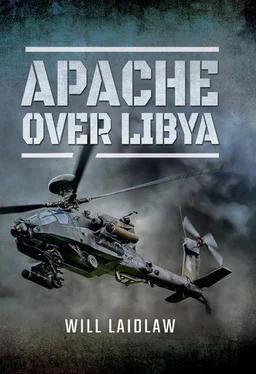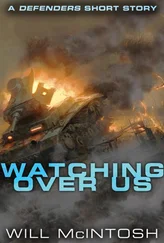I climbed down into the flip-flop. Big Shippers looked up at the chain ladder: ‘Sorry we’re late, bit of a bob and a weave on the egress. Small problem with helicopter hunters on the coast. Shot it, but then thought it wise to give the whole area a wide berth.’
‘No holes?’
‘None,’ Nick put in. ‘Techs won’t know until they get them into the hangar, but none felt.’
‘Fuel okay?’
‘To the pound. Spot on, in fact,’ Big Shippers answered.
‘Good. Now let’s see this helicopter hunter thing.’ I walked over to the guntape screens.
‘Ah, no, not yet,’ said Nick. ‘First you have to see what eight technicals look like before and after a trigger pull! We were down to ten-round bursts on the gun. We needed all five aircraft out there, it was swarming!’
I sat down in front of two screens, Underdog One’s guntape on the left, Underdog Two’s on the right, and began to watch the synchronized minute-by-minute playback of an extraordinary mission.
With Nick and Big Shippers filling in the detail of radio calls and incockpit communication not heard on the guntape, I tracked the timeline into the first target. What I saw was staggering. Eight vehicles, engines warm, weapons mounted and soldiers nearby, were parked right on the coordinates. The technicals were strung out in an east-west line beside an apparently abandoned set of sheds not far from the road. Underdog One had been looking at the first planned target area when Underdog Two had spotted them just a few hundred metres away. Around twenty pro-Gad soldiers sat 50m to the north of the technicals. As the aircraft closed and the crosshair of the FLIR interrogated the target, the soldiers got up and started walking with purpose, just a little too quickly to be natural, away from the technicals.
Nick described his thoughts: ‘That was it for me. They showed technicals and weapons. And that they were trying to put distance between themselves and the technicals completed the picture. That and the AKs you can see each of them carrying! I broke off and gave Underdog Two a laser target handover for the technicals.’
Nick, now too close to go straight into the attack, used his laser to hand over the confirmed targets to his wing aircraft. Jay’s FLIR, set to laser search mode, immediately settled on the technicals. The well-trained and experienced crew had anticipated Nick’s demands and were ready to take on the technicals.
Big Shippers took up the story: ‘It was difficult commanding from the back seat. There were so many targets we could have got three missiles off right away and steered each into a different technical, but I could see there were still some pro-Gad hiding in the folds of ground near the centre of the group. Jay was searching every technical for the best one to engage first. The one on the left looked empty so we went for that one, giving the poor sods a chance to change their minds.’
From the symbology on the guntape I could see Underdog Two was ready to fire, laser pulsing and missile seeker-head locked on. I watched the first Hellfire go in. The missile left the right-hand rail of the aircraft, briefly leaving some heat shimmer on the video image, then tracked for the concentration of laser energy on the first technical. It hit dead centre of the flatbed, just where a weapon, probably a ZU-23-2, was mounted. The technical was destroyed in a huge explosion, indicating more ammunition had gone up with the Hellfire hit. Jay’s sight then moved four technicals to the right before moving back to the left. There were still some pro-Gad trying to hide, lying down close to the right-hand vehicles, while others were crawling away close by. Jay brought the sight back left to the technical next along from the now intensely burning first target. Continuing to engage from the left would allow the pro-Gad further right to get up their courage and start running.
The second Hellfire ripped the next technical apart, detonating its ammunition. This was confirmation for the crawlers; they got up and ran for their lives. Jay checked the third technical and observed a soldier get up and run away to the right, before pulling the trigger for a third time and sending another Hellfire in. He was now too close for more Hellfire and needed to save some for the next target. Changing the FLIR polarity from white-hot to black-hot, he flicked his left thumb up to deaction the missile and bring his gun online. With the aircraft fast closing on his breakaway point, he sent four 20-round bursts of 30mm into the two central technicals. Switching back to white-hot FLIR, he sent another 100 rounds on five bursts into three more technicals, with Big Shippers guiding the aircraft on a left break.
The whole engagement, from first Hellfire hitting the left-hand technical to the last 30mm hitting the eighth technical to its right, took 1 minute 35 seconds. Eight technicals destroyed or damaged, no one dead and up to twenty-five pro-Gad out of work in just over a minute and a half. And Underdog hadn’t even got to their main target yet! This sequence was declassified the following day by the Ministry of Defence under the ‘defenceheadquarters’ tag and released to the media as an example of our activity that night. It can be seen on YouTube; just google ‘Apache Libya’. [11] http://www.youtube.com/watch?v=hHlk6Ss6Czo The MoD footage, not edited in chronological order, begins with the strike against the communications node on Okba airfield, then shows the 99th Hellfire strike against a technical, as described in the final quarter of this chapter. The footage then shows the destruction of eight technicals described above. In reality, the action took place as it is described in this chapter, but the footage is the actual guntape from that night
I turned the page over on Nick’s briefing pack and looked at the route to Okba, the primary target for the mission. Nick and Big Shippers clicked forward the infrared guntape and played part two of their night over Libya.
Okba airfield had been a regime airbase for decades. Well away from the bustle of the coast and the attention of Tripoli, it sat untouched in the desert. One road linked it north with Zuwara, 35 miles away, and the Nafusa Mountains, another 40 miles to the south. When the civil war began its accidental importance emerged, as a natural pro-Gad supply and staging post. Just as quickly, the third front line formed in the tribal areas of the mountains and NATO began searching for targets. Okba had been watched for months. It was active and gaining a reputation as an important part of Gaddafi’s southern operation. Occasional overflights had brought back photographs; analysts pored over them and concluded it was an active military area, no civilians, all activity nefarious and good to strike.
Only five miles north-east of the burning technicals, the regime operators at Okba would have heard the chaos coming from the sky, so the Apaches had to get there quickly and make fast decisions to maintain their momentum.
Now Underdog One and Two were banking hard round to the right, levelling out on their pre-briefed attack heading, infrared sights slaved to the Okba coordinates. Nick had two minutes to run, barely enough time to race through the pages on his MPDs, check his fuel state and weapons configuration and read the map. This was where meticulous planning, briefing and rehearsal took over. All four pilots knew what to do next. They’d all planned it, walked the map, the headings and the heights, briefed it and answered questions to check their understanding; now they were living it out second by second over Libya. NVG over the left eye, infrared zoomed in close over the right, both front-seaters went hunting for targets and threats.
From five miles out Okba looked quiet: no movement, just scores of silent buildings on an apparently disused desert airfield. They flew past the destroyed surface-to-air missile site to the south-west of the airfield, checking it was out of action, and settled their sights on the airfield itself.
Читать дальше












